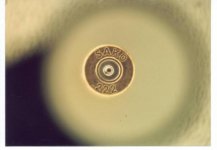JerrySharrett
Senile Member
Known facts from several sources tests, you are going to need AT LEAST 0.200" fall, AT LEAST 0.045" extension, and AT LEAST 18# of spring to get CONSISTENT ignition with today's small rifle primers!
.
.
At times like this I miss Steven Perry.
Sorry Blarson but stool and mikeinco are not "others," they're names used by one person who had to change names because guys like you thought he was "mean."
If you'd really searched and understood this subject you'd know that no firing pin has ever poked a hole in no primer.......EVER..... even if you can find opinions to the contrary. Unfounded opinions, un-TESTED opinions, but knee-jerk opinions nonetheless.
In simple fact, the reason I no longer post much here is because people like yourself find this "diversity of opinion" to be more interesting and more "fair" than tested facts.
And more important than safety.
sad
easy, the liberal way is ever filled with support......mob mentality is The New World Order.... garner enough supporting "friends" and you must, by fiat be "right," right?
but sad
Facts aren't up for vote, thankfully! (Although "support" is, sadly. And few care to differentiate)
Go freaking TEST IT before spouting opinions here!!! I'll know you're telling the truth when you tell us how you killed the primers used in the testing regimen.
The op asks a good question, relevant, it needn't be clouded by digressions into banality. Experts across the world, REAL experts, shooters and builders, have documented differences in ignition due to firing pin fall variation. I know of several people who get paid to address this very real issue for shooters in the BR community, and not ONE of them has ever "pierced" a primer. I've spoken with the authors of some of the best books and articles ever written on the subject of accuracy regarding the effect of the firing pin fall/protrusion/diameter/spring weight on accuracy. I know of several systems purposely DESIGNED and built to address this specific topic.......
And none of THEM has ever poked a hole in a primer either...
al



So here's my theory, the harder cups on the 450s are creating inconsistent ignition, resulting a flyer. The wolf standards would blank at this pressure range (wherever that is) so i didn't get to compare the GMM primers against another "soft" cup primer.
Yet it's clear that the primers or primer/ pin combo has more to do with the groups than I really gave credit to.
Adam
Adam on the CCI450 vs 205GM/s if you are shooting some of the high pressure loads we shoot in 6 BR and Dashers the 205's will not hold the pressure. Contrary to some beliefs magnum primers are not necessarily hotter but they will withstand higher pressures.
Your inconsistent ignition may be because you need a firing pin spring changeout. At Kelblys and Brownells new Wolf springs are in the $20-25 price range.
.
Hoping this is not comparing apples to oranges: I have found a 5% difference in muzzle velocity between std. and magnum primers (in handguns). If this is not due to the primer being 'hotter', what is the basis for the difference?
What chrono are you using that you can tell 5% difference in velocity. I would question your chrono's accuracy and inquire to your sample size.
I have Oehler 35 and a 43's and they are not that accurate even with the verify screens. Now if I were to space the screens 20 feet apart and change the clock pulse rate, going to probably a 100 or so sample size might tell us something.
Some where on there are photos of primer spark but that is not an indication of pop!
.
At times like this I miss Steven Perry.
it went downhill like a skier.
All this discussion on pin fall, protrusion, spring weight, consistency and blanking.....and no thought of the shape of the firing pin tip?
All this discussion on pin fall, protrusion, spring weight, consistency and blanking.....and no thought of the shape of the firing pin tip?
